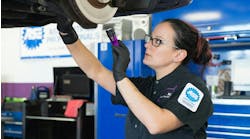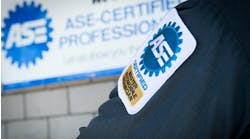I want to discuss an issue that has confounded me for some time: Why are there so few female commercial vehicle technicians? The accepted percentage is 3%-4%, though women make up more than half the population.
This while the industry faces a shortage of qualified labor.
“I don’t know how our industry gets fixed when 96% of the employees are one sex,” said Tyler Robertson, CEO and founder of Diesel Laptops, referring to the discrepancy between male and female technicians. “You’ve got to get females involved to help [fill these jobs] as well.”
How to do that efficiently still seems to evade fleet and shop recruiters, despite soaring entry-level wages for diesel technicians of $62,000 or more. Otherwise, the percentage of female technicians would be far less meager. Manufacturing, an industry I previously covered, made a big deal about the gender disparity, and that stands at 30% women to 70% men, according to the U.S. Department of Commerce. Having ten times less than that isn’t just a problem—it’s an embarrassment.
The stats don’t tell the whole story, though. There are some big differences between the jobs. CV maintenance can require more physical exertion than manufacturing tasks such as fabricating or assembling. Shops routinely do brake jobs, and those assemblies can be quite heavy—even Meritor’s lightweight EX+ LS Air Disc Brake weighs 71 lbs. And Class 8 truck tires weigh 110 lbs.
Save for some behemoth tech affectionately named Ox who can lug those around without breaking a sweat, any tech, male or female, can and should leverage shop material handling equipment like brake drum dollies for heavy lifts, or get help. With labor in short supply, it’s not worth the risk for a pulled muscle or hernia.
“There are some jobs that are physically demanding that you need to be able to perform, but that doesn’t mean women or anyone else can or cannot do those jobs,” noted Robert Braswell, executive director of American Trucking Associations’ Technology & Maintenance Council.
And Braswell dismissed the notion that women in general are more likely to hinder shop productivity, but the stickler for metrics noted that with all technicians, “you need to set your standards and your expectations to what you think they need to be, and then apply them consistently across the board.”
Basically, treat everyone equally when it comes to judging performance. And the word from the industry is that women can absolutely perform the job.
“In my experience, some of the best techs that I’ve seen were females,” said Adam Duplin, diesel technology coordinator at New Village Institute-Blairsville, a training center that opened this year in Pennsylvania. “They have a different methodical approach and are very detail-oriented, and they just do a really good job.”
Duplin noted that at the high-school level, it’s still difficult to overcome the pervasive stigma “that this isn’t a girl’s job.”
“From a physical standpoint, there’s nothing making this a man’s-only job,” he added.
The industry is starting to come around to that belief.
Diesel and automotive trade school WyoTech in Laramie, Wyoming, has found success recruiting women. CEO Jim Mathis said 5% to 8% of the student population is female. “We’re looking for more because they are awesome,” he said. “And they’re smarter and more detail-oriented—and easier on equipment and tools and everything else. We want more, and the opportunities for them are limitless.”
WyoTech has a goal of educating 10,000 students per year and will never reach that goal without women, who represent 51% of the population. One way they are doing that is evaluating what curricula and programs would be more inclusive, Mathis said.
A new club at the school, called Women of WyoTech (WOW), has started providing a place for female students to talk about their collective challenges and support one another. Penske and United Rentals already have shown great interest in WOW’s 15 members and are attempting to recruit them into their shops through visits to the school and invitations to their dealerships.
There’s still plenty of work to do. Ellen Voie, CEO of the Women In Trucking Association, a group dedicated to showing women have a place in the transportation industry, shared these results from a recent report:
- 94% of respondents say they have no women in technician roles.
- 2% say they have 10%-20%.
- 2% report they have 30%-40%.
- 2% reported plus-90% (though Voie said these were small companies with few techs).
This is not an issue that will be solved overnight, but it’s also one that we’ve all known about for decades. The difference is that now the industry is at an inflection point where the job is less about tearing down engines and more about finding problems via computers to increase an engine’s life. And many in the industry, who have a vested interest in its success, say an influx of female techs will help ease the labor crunch.
I don’t know how it will all turn out, but I do know vehicles will always need maintenance, and the earlier you get girls involved, the better their career prospects. Now excuse me, as I am going to teach my daughters about torque by defeating their Fisher Price Power Wheels car’s speed limiter device (a screw).




